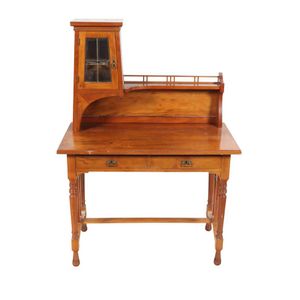Early 20th Century Arts & Crafts Walnut Desk
Arts & Crafts desk early 20th century walnut, with bevelled leadlight glazed door, two drawers below on stretched base, height 141 cm, length 100 cm, depth 52 cm
You must be a subscriber, and be logged in to view price and dealer details.
Subscribe Now to view actual auction price for this item
When you subscribe, you have the option of setting the currency in which to display prices to $Au, $US, $NZ or Stg.
This item has been sold, and the description, image and price are for reference purposes only.
- Bevel / Chamfer - In furniture making, a chamfered corner refers to a technique used to create a smooth, angled edge on the corner of a piece of furniture. This is typically done by cutting away a small portion of the corner at an angle, typically 45 degrees, creating a diagonal edge, rather than a sharp 90-degree angle. This technique can be used on various parts of a piece of furniture such as table legs, drawer fronts, or door frames. Chamfering can add visual interest to a piece and can help to soften the overall look of a piece of furniture. It is often used in conjunction with other techniques, such as rounding edges or using contrasting wood species to create a more elegant, sophisticated look. Chamfering is a simple way to add a touch of elegance to a piece of furniture and it is a common technique used by furniture makers.
- Leadlighting - The use of stained glass, held together with leaded strips, sometimes found in cabinet furniture. While stained glass is not uncommon in Victorian houses, it is unusual to find it in furniture before the end of the 19th century. It was favoured by cabinetmakers for sideboards and smaller pieces such as dinner trolleys, in the style of the Art Nouveau, and is often found in kitchen cabinets and display cabinets dating from the 1930s and 1940s.
This item has been included into following indexes:
